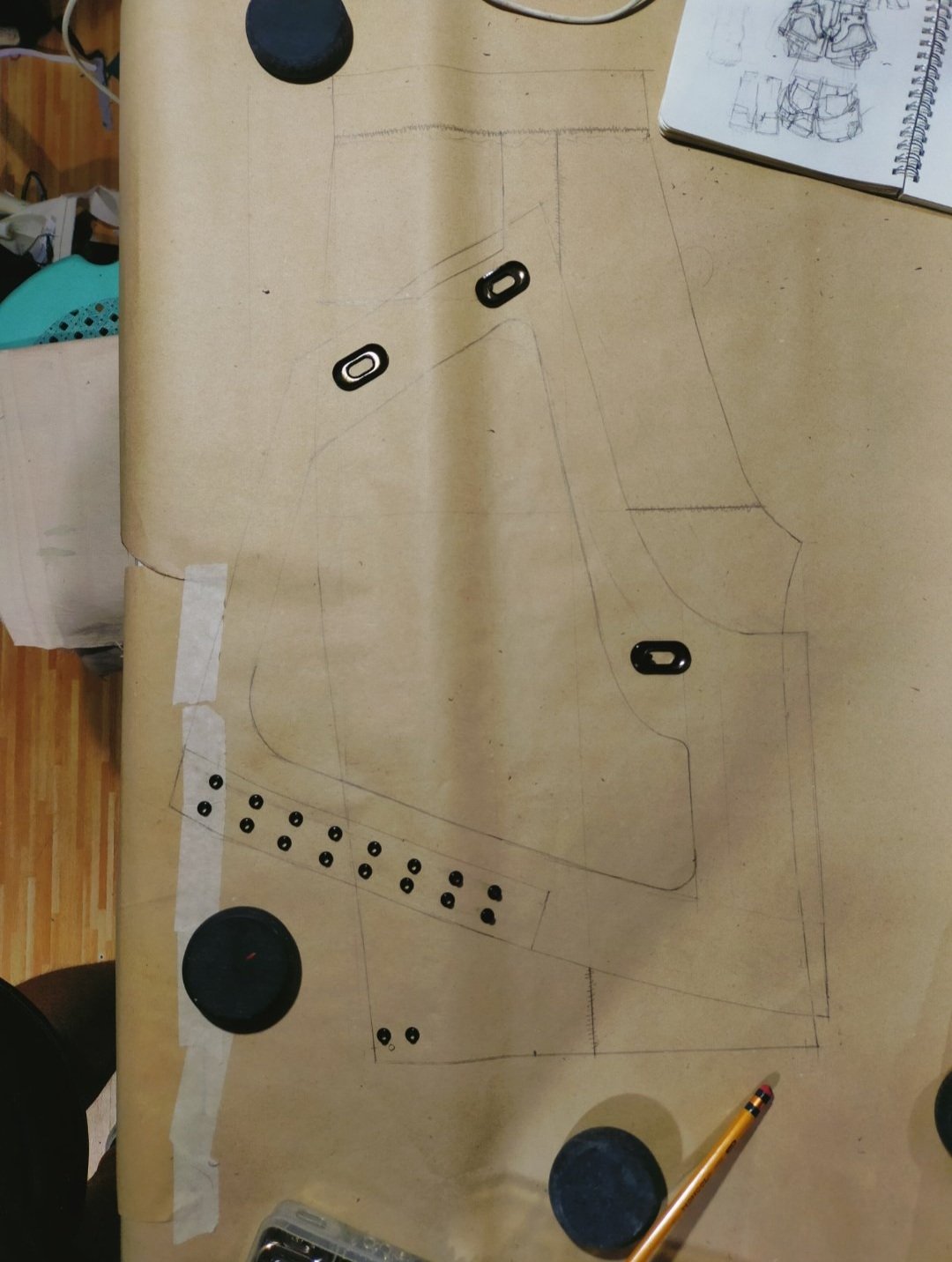Fresh Faces: Eugene Malabad
Capturing Manila’s urban landscape in ‘Rotonda’
By Sharrona Valezka
FAM FRESH FACES is a series featuring young Southeast Asian fashion practitioners, where we speak with them about how they embarked on their careers and what propels them as creatives.
Eugene Malabad is a fashion designer hailing from Manila, Philippines, and the founder of the emerging brand Kill Joy Studios. After graduating from iAcademy with a BA in Fashion and Technology last year, he was chosen by the PHx Fashion Group to showcase his designs at the MaArte Fair at The Peninsula Manila, a fundraising bazaar which benefits the Museum Foundation of the Philippines. Eugene finds inspiration in small, overlooked details in his daily life, such as his commuting routine. This was then translated into Kill Joy Studios’ collection, ‘Rotonda’, which captures the bustle of Manila’s urban landscape through the vibrantly coloured line-up of garments.
Eugene Malabad.
To start, could you talk about your background? What or who are the main influences your work draws upon?
My name is Eugene Malabad, and I am a 24-year-old fashion designer from Pasay City, Metro Manila, Philippines. The streets of Metro Manila never fail to captivate my senses. Growing up in this bustling city, I have been immersed in its vibrant energy and fast-paced beat. As a dedicated commuter, I am constantly fascinated by how my daily journey has transformed into a unique rhythm, seemingly undisturbed by the ever-changing urban landscape. I have formed a special connection with my route that transcends the mere physicality of the streets themselves.
I take comfort in being the one constant amidst the shifting urban scenery. It is almost as if I have carved out my own distinct niche within the intricate fabric of city life—a silent protagonist in the unfolding narrative of urban existence. My creative practice is fueled by small details that are often overlooked by others, from the resounding music heard from passing public transportation to the nuances and individuality of people on the move, and the myriad visual elements that surround me.
“As a dedicated commuter, I am constantly fascinated by how my daily journey has transformed into a unique rhythm, seemingly undisturbed by the ever-changing urban landscape. I have formed a special connection with my route that transcends the mere physicality of the streets themselves.”
Kill Joy Studios, ‘Rotonda’ collection, 2022. Image courtesy of Eugene Malabad.
Kill Joy Studios, ‘Rotonda’ collection, 2022. Image courtesy of Eugene Malabad.
How did the initial process of creating your brand come about? What was the story behind it?
Entering design school while I was in my senior year has provided me with the opportunity to articulate myself. Since I was one of the students who was more expressive in class, I could not help but feel that the regulations and conventions in school were overly restrictive.
One afternoon in 2017, I was sketching a jacket I intended to create as a do-it-yourself project in my classroom. The plan was to adorn it with hand-painted designs on the chest and back. When I began contemplating adding text to the back yoke of the jacket, the term ‘killjoy’ popped into my mind. After the words were embedded in my thoughts throughout the day, I realised that they perfectly encapsulated the underlying ideas of my designs, my creative work, and my perspective on life. From that point on, I associated this term with every art project and assignment I undertook, extending this connection into my college years.
In 2022, I had just graduated from iAcademy when I received the opportunity to showcase my graduation collection, 'Rotonda, at the MaArte fair organised by the PHx Fashion Group. It was a pivotal moment when people began to take notice of my brand, and it started gaining momentum. There was a point when I hesitated to use Kill Joy Studios as my debut brand name, as I was unsure if it truly represented my identity as an artist and designer. However, I soon realised that no other term encapsulated who I am more effectively. While my brand is still in its early stages, I am excited about sharing stories and expressing myself through it, as well as building meaningful connections with people through my clothing.
Eugene’s design work when studying at iAcademy. Images courtesy of Eugene Malabad.
You recently graduated from iAcademy with a BA in Fashion Design and Technology in 2022. What has been the most significant shift from designing as a fashion student, to becoming a professional fashion practitioner?
As a fashion student, when it came to designing, I could freely translate my ideas into real-life creations without worrying much about wearability or its retail potential. I could execute any concept I imagined without any other consideration aside from my own creative taste. However, now that I am a practising designer, I have come to understand that there are numerous factors to consider. While my artistic language remains important, I must also align with the needs of my specific audience or niche. Being in the industry has made me realise that I am not just a creative, but a designer who caters to customers. I must balance my personal interests with the commercial aspects of my work and consider the business side of things to succeed.
Kill Joy Studios, ‘Rotonda’ collection, 2022. Image courtesy of Eugene Malabad.
Let’s talk more about ‘Rotonda’, your label’s latest collection launched last year. What was the inspiration behind it? Are there any specific elements in the garments that you would want people to pay attention to, and why?
As I shared, my creative inspiration was drawn from the streets of Metro Manila. For this collection specifically, I aimed to narrate my personal commuting experiences in Pasay Rotonda, where I spent most of my formative years. The first design element in my collection is the macramé pieces, which were inspired by the cable wires that drape across the utility posts lining the streets. While many consider these wires an eyesore, they captivate me because of their gritty and raw aesthetic. I deliberately introduced the black macramé element as a visual contrast to the vibrant colours used elsewhere in the ‘Rotonda’ collection.
Next, the gradient colours in my designs seek to replicate the way I perceive my surroundings from a moving vehicle. I am enamoured by how bright, contrasting colours tend to blend together in motion, which creates a unique visual effect. Lastly, a distinctive feature in my designs is the twist knob, reminiscent of the hardware often seen in the improvised windows of jeepneys and tricycles, known as trapals, used to shield passengers from rain and other elements.
Behind-the-scenes process of creating ‘Rotonda’ collection. Images courtesy of Eugene Malabad.
Could you share more of the creative and technical process of creating a collection in general? What materials or techniques are your favourites to work with?
My creative process usually starts with a deep immersion into my source of inspiration. I meticulously capture photographs of every inspiring detail to materialise my vision. Regardless of how disparate these elements may initially appear, the beauty lies in seamlessly weaving them together into a cohesive narrative.
From these visual cues, I then conjure a world where my clothing creations "come to life". By envisioning this hypothetical realm, I can begin to contemplate how to translate it into the realm of reality. Moving forward from these imaginative stages, I dive into the technical aspects, which encompass design development and pattern-making. This phase is often meticulous and entails a trial-and-error process. Additionally, for materials other than macramé, I have a fondness for utilising stiff and structured fabrics such as denim, leather, and canvas in my designs.
Behind-the-scenes process of creating ‘Rotonda’ collection. Image courtesy of Eugene Malabad.
“I meticulously capture photographs of every inspiring detail to materialise my vision. Regardless of how disparate these elements may initially appear, the beauty lies in seamlessly weaving them together into a cohesive narrative.””
Eugene’s design work when studying at iACADEMY. Image courtesy of Eugene Malabad.
Kill Joy Studios was featured at PHxMaArte last year to represent the current fashion landscape in the Philippines. As an emerging local designer, what are some of the key challenges you face and equally, opportunities that you seek?
Being an emerging practitioner in the Philippine fashion industry, I have already had my fair share of struggles. To start, sourcing raw materials can be quite challenging due to the limited options available. Moreover, in the Philippines, there is a common misconception that all designers are essentially the same and primarily skilled in creating glamorous gowns. Many people in the Filipino market fail to recognise that each designer possesses a unique design language.
Another common tendency among consumers is to compare the prices of ready-to-wear items from well-known retail brands with those from small, local fashion designers. Often, people opt for the former because of the lower cost and the brand's popularity.
Regarding the opportunities I aspire to find, I hope to witness the emergence of more platforms similar to the PHx Fashion Conference that can support emerging designers and startup brands. Despite the multitude of challenges, I am truly thankful for the opportunity to present my work at PHx MaArte and introduce Kill Joy Studios to the local market. This experience has made me realise that when placed in the appropriate context and with the right exposure, my creations possess market appeal. The existence of such avenues can also contribute to the establishment of a distinct Filipino fashion identity.
What are your hopes for your local fashion scene, and in Southeast Asia as well?
I hope to see more designers inspired to infuse a distinct Filipino essence into their collections. It is high time for us to fully embrace our unique Filipino identity and collaborate to define what Filipino fashion truly is. I also envision the emergence of an organisation similar to the PHx Fashion Group that could serve as a hub for emerging designers from various Southeast Asian countries to come together and share their creative visions.
Kill Joy Studios, ‘RTND LARGA BAG’, 2023. Image courtesy of Eugene Malabad.
Finally, what are your plans for your label moving forward?
I am planning to expand my team in the near future and look forward to bringing experienced pattern makers and skilled sewers on board. Currently, I am running my brand on my own with the help of my father for the macramé pieces. I also seek the assistance of my fellow emerging designer friends and interns whenever we have an event to attend. The future, however, remains uncertain, as I am doing my best to not look too far ahead into the future and just savour the moments day by day.
See more of Eugene’s work on Instagram at @itseugenemalabad and at @killjoystudios_official.






















